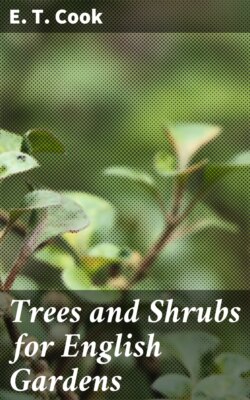Читать книгу Trees and Shrubs for English Gardens - E. T. Cook - Страница 6
ORNAMENTAL PLANTING IN WOODLAND
ОглавлениеWhere woodland adjoins garden ground, and the one passes into the other by an almost imperceptible gradation, a desire is often felt to let the garden influence penetrate some way into the wood by the planting within the wood of some shrubs or trees of distinctly ornamental character.
Such a desire very naturally arises—it is wild gardening with the things of larger growth; but, like all forms of wild gardening (which of all branches of gardening is the most difficult to do rightly, and needs the greatest amount of knowledge), the wishes of the planter must be tempered with extreme precaution and restraint. It does not do to plant in the wild garden things of well-known garden character. This is merely to spoil the wood, which, in many cases, is already so good that any addition would be a tasteless intrusion of something irrelevant and unsuitable.
IN THE WOODLAND AT KEW, SHOWING TREE AND SHRUB BY GRASSY WAY.
Still, there are certain wooded places where a judicious planting would be a gain, and there are a certain number of trees and shrubs which those who have a fair knowledge of their ways, and a true sympathy with the nature of woodland, recognise as suitable for this kind of planting. They will be found in these classes: Native growths that are absent or unusual in the district, such as the Spindle Tree (Euonymus), White Beam, Service Tree, White and Black Thorn, Wild Cherry, Bird Cherry, Wild Guelder Rose (Viburnum Opulus), and V. Lantana, Honeysuckle, Wild Roses, Juniper, and Daphne Laureola.
WAYFARING TREE (Viburnum Lantana); A NATIVE SHRUB ON CHALK.
Then, among cultivated trees and shrubs, those that are nearly related to our wild kinds, including some that are found in foreign woodlands that have about the same latitude and climate as our own. Among these will be Quinces and Medlars, many kinds of ornamental Cratægus, Scarlet Oaks, various Elders and Crabs, and the grand Pyrus americana, so like our native Mountain Ash, but on a much larger scale.
A very careful planting with trees and shrubs of some of these and, perhaps, other allied kinds, may give additional beauty and interest to woodland. Differences of soil will, of course, be carefully considered, for if a piece of woodland were on chalky soil, a totally different selection should be made from one that would be right for a soil that was poor and sandy.
In moist, sandy, or, still better, peaty ground, especially where there is a growth of Birches and Scotch Firs, and not many other kinds of trees, a plantation of Rhododendrons may have a fine effect. But in this case it is better to use the common R. ponticum only, as a mixture of differently coloured kinds is sure to give a misplaced-garden look, or an impression as if a bit of garden ground had missed its way and got lost in the wood.
